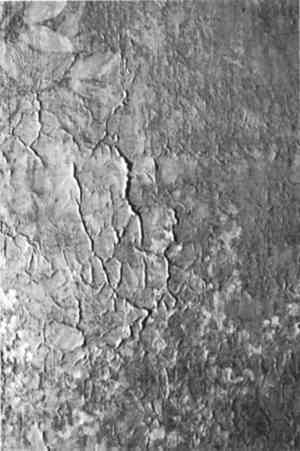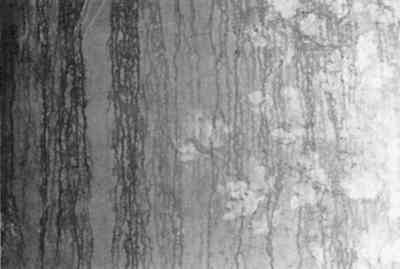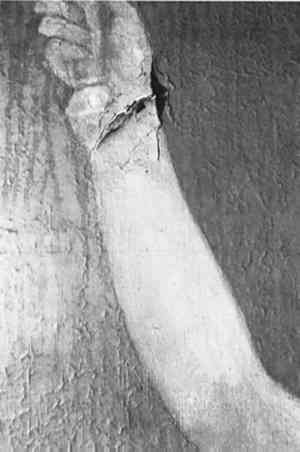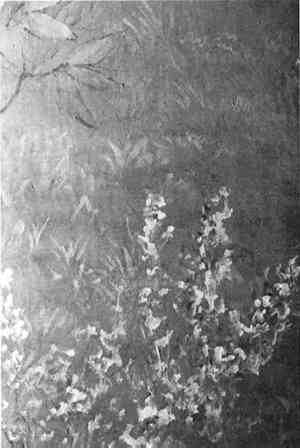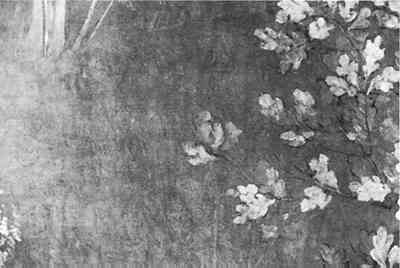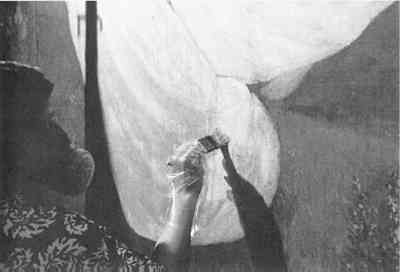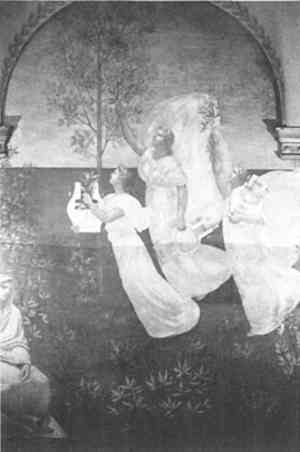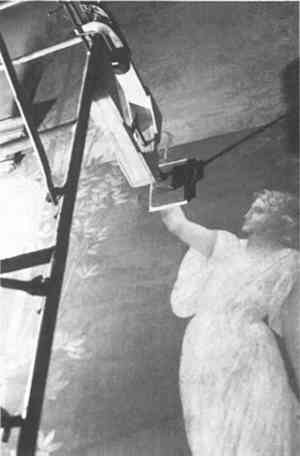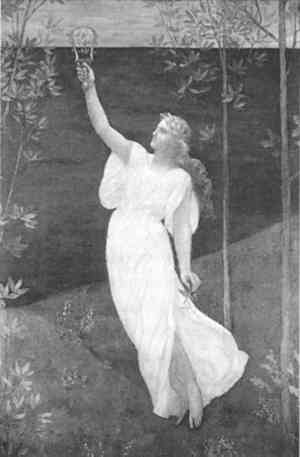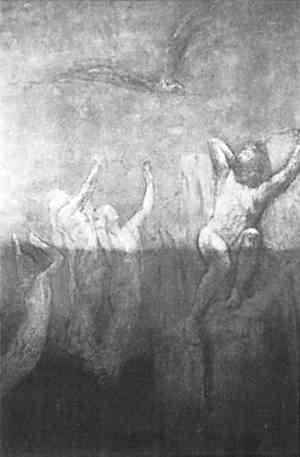PUVIS DE CHAVANNES'S ALLEGORICAL MURALS IN THE BOSTON PUBLIC LIBRARY: HISTORY, TECHNIQUE, AND CONSERVATIONTERI HENSICK, KATE OLIVIER, & GIANFRANCO POCOBENE
4 CONSERVATIONDocumentary evidence indicates that Puvis's murals were restored on at least three previous occasions. The first documented treatment occurred in 1930 when they were cleaned and coated by Charles Durham. Commenting on that early restoration, Edward Forbes wrote that “the protective surface that was put on … was a mixture of the white of egg combined with some other ingredients, which makes a sort of varnish and has given the paintings a slight gloss” (Forbes 1940). In 1940, the restorer R. Arcadius Lyon cleaned the murals with a weak solution of castile soap (sodium carbonate and olive oil) and water. At that time he found that the previously applied egg white coating was tough and well adhered and that it did not respond well to his cleaning efforts. Fearing possible damage to the paint layers, he chose not to try stronger cleaning solutions and decided to leave the coating on the surface (Forbes 1940). Finally, Finlayson Brothers restored the murals in 1953, but they do not appear to have left any documentation of the treatment. As part of a major restoration program for the library, the murals were scheduled for conservation in 1994. They were generally in a very good state of preservation but did require surface cleaning, consolidation of minor flaking, and retouching of minor abrasions. During the early phase of the renovation, however, an unfortunate event necessitated the immediate conservation treatment of The Inspiring Muses. In the early morning hours of February 3, 1992, the painting was badly damaged by water condensing on its surface as a result of an accidental steam valve release. Fortunately, the other eight murals on the staircase were not damaged, as they had been covered with multilayer barriers to protect them from the renovation work. Kate Olivier, who was the first conservator from the Straus Center for Conservation to arrive at the scene, found the area still full of hot, white steam and described it as “like being in a Turkish bath.” The first RH reading, taken that morning shortly after 9:00 a.m. was 87%, but it surely must have been very near 100% earlier that morning. Fans were installed in the staircase windows to extract the damp air. By midafternoon the RH had dropped to 77%, and by the next morning it had dropped to 55%. Later, a protective polyethylene barrier was draped around the scaffolding in front of the mural, and humidifiers were placed in the enclosure to control the humidity level. The steam caused three specific types of damage. The most serious was extensive lifting and tenting of the paint layers that affected approximately 40% of the painting (fig. 7). Most of the damage occurred on the right half of the mural; fewer and smaller sections were affected on the left half. Why this occurred is not entirely clear, but a likely explanation is that variations in air currents increased the amount of water condensation on the right. Fortunately, the canvas did not shrink very much because of its strong attachment to the wall. The areas of lifting varied in severity over the surface of the painting. The worst damage occurred along the bottom
Given the urgency of the situation, consolidation tests were begun immediately. Access to the entire surface of the mural was provided by the fixed scaffolding that had been installed for other renovation activities. Of the many adhesives considered, the two adhesives finally selected for testing on the mural were sturgeon glue and BEVA 371. Both were effective in readhering the paint layers. The BEVA 371, however, held the flaking paint more effectively during the removal of the excess adhesive. In addition, it would not be affected by water-based cleaning solutions that would later be required to remove the surface grime and stains; it would not cause further canvas shrinkage during application; and it would be less affected by fluctuations in temperature and relative humidity. The BEVA 371 adhesive, diluted (1:1) in benzine
After the consolidation was complete, the fixed staging was replaced in favor of rolling scaffolding, which allowed more flexibility and
A number of conservators and conservation scientists have expressed concerns about the use of some of Wolbers's cleaning solutions. They question the solubility effects of various components on the paint layers, the difficulties of clearing surface residues, and the long-term effects of residues that might remain on the paint layers. These issues led to repeated, painstaking rinsing of the mural surface. Given its size and the quantities of cleaning solution used, it is still possible that some residues remain. However, no other cleaning solution was found to remove the accumulated grime and staining. In the white drapery of the Muses the redeposited accretions and streaks were also removed, but it became evident after cleaning that the paint layers had been darkened slightly by the condensing steam. While the nature of this darkening effect was not determined, possible causes include: (1) the conversion of lead The detached canvas areas were plasticized by the application of local moisture and pressure. To apply the necessary pressure, a jig made from a veneer press was secured to the scaffolding using C-clamps (fig. 14). Dampened blotters, sections of foam (to allow the blotter to conform to the distortion), and a Masonite board were placed against the delaminated canvas, and gentle pressure was exerted. After some 40 minutes the paint and canvas were sufficiently plasticized, and the dampened blotters and foam were removed. They were replaced with dry blotters, a 1/4 in. thick Ethafoam section, and a Masonite board and left in place overnight to allow the canvas to dry flat. The detached canvas was then readhered to the wall with Jade 403 (polyvinyl acetate emulsion), and the adhesive was allowed to set under the pressure of Mylar, blotters, and Masonite board for 24 hours. Although Jade 403 is basically an irreversible adhesive, it is sufficiently weaker than the lead white paste and was chosen for its strength and flexibility.
In comparison to the scale of the mural, the losses were small and relatively few. Filling of the losses was not necessary since they occurred in the thinnest paint layers and thus would not be noticeable from a normal viewing distance. The losses and irreversible remnants of the drip marks were inpainted with Bocour Magna Colors (fig. 15). These paints were chosen for their reversibility and appropriate degree of opacity to match the original colors. Although the colors have been discontinued, the Straus Center for Conservation still has a full complement. Retouchings that dried too matte were glazed and adjusted with Acryloid B-72 in xylenes.
Once conservation of The Inspiring Muses was completed, treatment proceeded on the other eight murals in the staircase. Apart from Philosophy, which has had a history of structural problems, these murals were in good condition and required very little consolidation. Surface grime was thick throughout, but especially obscuring
Although the Boston murals were not originally varnished, consideration was given to the possibility of applying a protective coating. Issues of public accessibility, vandalism (thus far not a problem), and the redeposition of grime were the main concerns. Natural resins and most synthetics were considered but rejected because of their high saturating properties and poor aging characteristics. Acryloid B-72 was chosen for testing because of its stability and lower saturating properties. It was applied by brush in concentrations ranging from 2 to 6% in xylenes. It was clear to conservators and art historians who were consulted that varnishing would impart far too much saturation and gloss to be aesthetically acceptable. Another concern was the solubility effect that aromatic hydrocarbon solvents would have on the BEVA 371 that was used to consolidate the paint layers should it become necessary to remove the varnish in future treatments. Furthermore, Puvis's clear desire for a matte surface dictated that the murals should remain unvarnished. After the grand staircase was reopened to the public, low display cases were placed against the dado below The Inspiring Muses to create a partial barrier between the mural and visitors to the library. |
